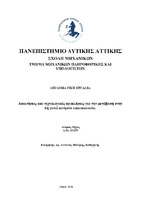| dc.contributor.advisor | Bogris, Adonis | |
| dc.contributor.author | Ρήγας, Ανδρέας | |
| dc.date.accessioned | 2024-04-23T07:03:42Z | |
| dc.date.available | 2024-04-23T07:03:42Z | |
| dc.date.issued | 2024-03-22 | |
| dc.identifier.uri | https://polynoe.lib.uniwa.gr/xmlui/handle/11400/6572 | |
| dc.identifier.uri | http://dx.doi.org/10.26265/polynoe-6408 | |
| dc.description.abstract | Όταν τον 1966 στις ΗΠΑ άρχισε να προβάλλεται η σειρά Star Τrek, ίσως κανείς, τότε, δεν θα μπορούσε να φανταστεί ότι η μικρή ασύρματη συσκευή επικοινωνίας που χρησιμοποιούσαν οι ηθοποιοί, και εμφανιζόταν για πρώτη φορά και προφανώς δεν δούλευε, θα είχε τέτοια αποδοχή από τον κόσμο. Υπάρχουν περίπου 8 δις άνθρωποι στη γη και κυκλοφορεί υπερδιπλάσιος αριθμός συσκευών κινητής επικοινωνίας.
Αυτό που σίγουρα ήταν αδύνατο να προβλεφθεί είναι η τρομερή τεχνολογική εξέλιξη στις ασύρματες επικοινωνίες και κυρίως στις απίστευτες εφαρμογές που έχουν ήδη υλοποιηθεί και στις εξωφρενικές υπηρεσίες που βρίσκονται στο στάδιο της σχεδίασης.
Το αντικείμενο αυτής της εργασίας είναι μια μελέτη για τις τεχνολογίες που απαιτούνται για την μετάβαση στην 6η γενιά των ασύρματων επικοινωνιών και τις βασικότερες εφαρμογές που θα προκύψουν με την υλοποίηση αυτών των τεχνολογιών.
Αρχικά, θα γίνει μία αναφορά - αναδρομή στις τέσσερεις πρώτες γενιές ασύρματων επικοινωνιών. Στη συνέχεια, μία μεγαλύτερη ανάλυση της τεχνολογίας 5G, πολλές πτυχές της οποίας αποτελούν την βάση εκκίνησης για την 6G.
Κατόπιν, ακολουθεί ένας συσχετισμός των τεχνολογιών Industry 4.0 και 6G. Συγκεκριμένα, πρώτα γίνεται αναφορά στην τεχνολογία Industry 4.0 και μετά καταδεικνύεται η σχεδόν παράλληλη πορεία Industry 4.0 και 6G με αναφορά σε σχετιζόμενες τεχνολογίες.
Στη συνέχεια, μία μεγαλύτερη ανάλυση των βασικότερων τεχνολογιών του 6G και μία εκτενή περιγραφή των βασικότερων εφαρμογών που έχουν προταθεί και βρίσκονται σε επεξεργασία στο τραπέζι της σχεδίασης.
Η εργασία ολοκληρώνεται με την εξαγωγή ορισμένων συμπερασμάτων και αποτύπωση μελλοντικών προκλήσεων. | el |
| dc.format.extent | 67 | el |
| dc.language.iso | el | el |
| dc.publisher | Πανεπιστήμιο Δυτικής Αττικής | el |
| dc.rights | Αναφορά Δημιουργού - Μη Εμπορική Χρήση - Παρόμοια Διανομή 4.0 Διεθνές | * |
| dc.rights | Attribution-NonCommercial-NoDerivatives 4.0 Διεθνές | * |
| dc.rights.uri | http://creativecommons.org/licenses/by-nc-nd/4.0/ | * |
| dc.subject | 5G | el |
| dc.subject | 6G | el |
| dc.subject | Διαδίκτυο πραγμάτων | el |
| dc.subject | Τεχνητή νοημοσύνη | el |
| dc.subject | Ασύρματες επικοινωνίες | el |
| dc.subject | Εικονική πραγματικότητα | el |
| dc.subject | Επαυξημένη πραγματικότητα | el |
| dc.subject | Μηχανική μάθηση | el |
| dc.title | Απαιτήσεις και τεχνολογικές προκλήσεις για την μετάβαση στην 6η γενιά κινητών επικοινωνιών | el |
| dc.title.alternative | Requirements and technological challenges for the transition to the sixth generation of mobile communication | el |
| dc.type | Διπλωματική εργασία | el |
| dc.contributor.committee | Karkazis, Panagiotis | |
| dc.contributor.committee | Μυριδάκης, Νικόλαος | |
| dc.contributor.faculty | Σχολή Μηχανικών | el |
| dc.contributor.department | Τμήμα Μηχανικών Πληροφορικής και Υπολογιστών | el |
| dc.description.abstracttranslated | When Star Trek first aired in the US in 1966, perhaps no one at the time could have imagined that the small wireless communication device 'used' by the actors, appearing for the first time and apparently not working, would be so well received by the people around the world. There are about 8 billion people on earth and over twice as many devices in circulation.
What was certainly impossible to foresee, is the tremendous technological development in wireless communications and especially the incredible applications that have already been implemented followed by the outrageous services that are in the design stage.
The subject of this dissertation is to study the technologies required for the transition to the 6th generation of the wireless communications along with the prominent applications that will emerge following the implementation of those technologies.
First, a reference - review will be presented, on the first four generations of wireless communications technologies. Next, an extensive breakdown of 5G technology, many aspects of which are the launching pad for 6G.
Then, a correlation of Industry 4.0 and 6G technologies follows. Specifically, first the Industry 4.0 technology is mentioned and then, the almost parallel course of Industry 4.0 and 6G is demonstrated, with reference to related technologies.
Following, is a greater analysis of the key technologies of 6G and an extensive description of the key applications that have been proposed and are being processed at the design table.
The dissertation concludes by drawing conclusions and outlining future challenges | el |


